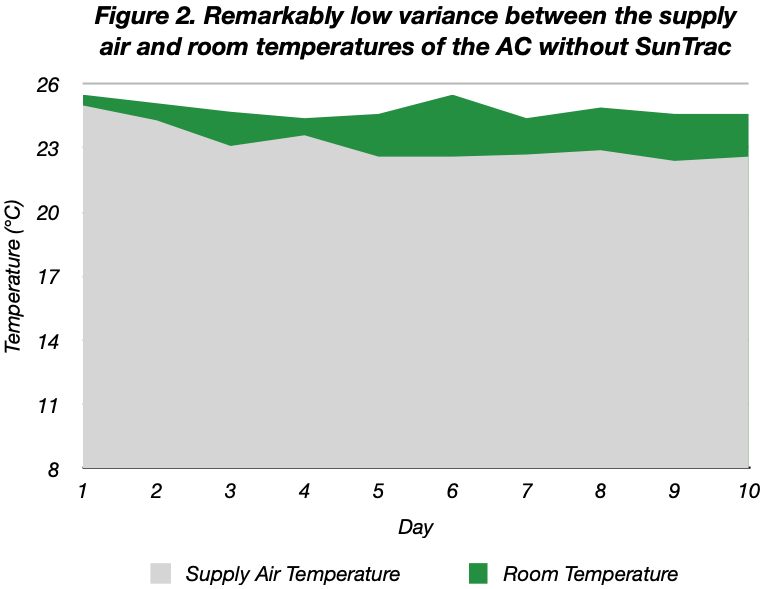The SunTrac Solar Thermal SmartPanel is an energy efficient aircon technology where pressure and heat are added to the refrigeration cycle, which reduces the required workload of the compressor and lowers the overall power consumption of the system.
It now has a fully operational pilot installation in the Philippines at the Department of Energy in Taguig City, Philippines. Located at the 4th floor deck of the DOE Main Building, the SunTrac Panel has been efficiently supplementing a 4-Ton Daikin inverter air conditioner since it was installed in June 10, 2021.

The attached 4-Ton Daikin inverter unit only draws 1.78 amps with the SunTrac Panel
Data from the Daikin unit indicates an average amp draw of 1.78 A and kilowatt rating of 0.3905 kW, which are astoundingly low for a 4-Ton air conditioner. The DOE conducted a comparative study involving an identical Daikin AC unit and the results showed a percentage improvement of up to 91% for the Daikin unit with SunTrac.
From the outcome of this project, the SunTrac Panel is proven to yield significant savings in electricity costs from air conditioning and increases the performance efficiency of the air conditioner, thus, also minimizing compressor wear and tear and repair expenses.

The Department of Energy indicated a 91% improvement rating for an air conditioner with SunTrac
The Department of Energy — Energy Utilization Management Bureau released an official report documenting all of their findings from the SunTrac Pilot Project.
Based on the data, the ampere reading to deliver the room temperature from a reference supply air temperature decreased significantly with the enhancement provided by the Suntrac Solar Thermal SmartPanel (from an average of 10.605 amps, down to 1.78 amps with the enhancement). With Daikin 1, the difference between the supply air and set point temperatures is significantly low which is an indication that the compressor is working more efficiently in delivering the desired room temperature.
The succeeding table shows the actual improvement on the kW rating of the ACUs. Actual kW rating decreased by 1.943 kW on the average from 2.333 kW to 0.3905.
– Excerpt from DOE’s official report
Comparative Study
This study involved the monitoring and gathering of comparative data from two air conditioners with identical outdoor units (Daikin 3.5 TR, Model: RZR125MVM). The main air conditioning unit is attached to the 8 x 4 feet SunTrac Solar Thermal SmartPanel, while the comparative unit is operating on its own.
Data was gathered once a day over two phases, each consisting of five consecutive workdays. In the first phase, the temperature set point (independent variable) of the air conditioning units was set to 25°C. This was subsequently lowered to 24°C in the second phase to further observe differences in performance.

With the SunTrac Solar Thermal SmartPanel, the main air conditioning unit only drew a little above one (1) amp through most of the evaluation period. It exhibited a steady amp draw, even when the temperature set point was lowered (from 25°C to 24°C) in the second phase of the study. These are remarkable results for a 3.5 TR air conditioner, which would normally draw 15 amps on its own.
On the contrary, the comparative unit without SunTrac recorded a fluctuating and increasing amp draw across the ten-day period. It went as high as 21.5 amps on Day 9 and exhibited dramatic dips and spikes especially after the adjustment of the set point.
From these findings, there is a significant difference in amp draw between the main air conditioning unit with SunTrac and the comparative unit which operates on its own.
A smaller difference between the temperatures of an air conditioner’s supply air and that of the surroundings (room temperature) translates to a more energy efficient aircon system and is better for the unit’s overall performance.
A high variance between the supply air and room temperatures can mean that the unit’s compressor is overworked, which speeds up its wear and tear.
The green areas in the above graphs depict the low and high variances of the two air conditioning units.





